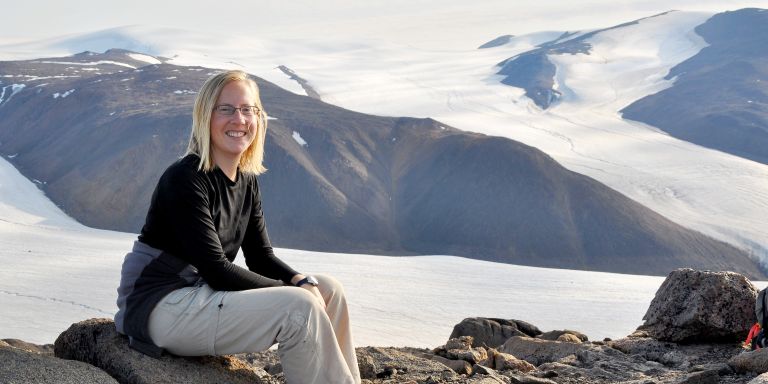
Anne Bjorkman
PhD, Ecology and Evolutionary Biology
Wallenberg Academy Fellow 2019
Institution:
University of Gothenburg
Research field:
Global change ecology with a focus on plants


Wallenberg Academy Fellow 2019
Institution:
University of Gothenburg
Research field:
Global change ecology with a focus on plants
In the Arctic – the huge area of land and sea surrounding the North Pole – climate change is reflected by a more rapid rise in temperature than elsewhere. Changes occurring here can therefore inform our predictions for the rest of the world.
In addition, huge amounts of carbon are stored in the arctic tundra. As the climate warms and the ground thaws, there is a risk that this carbon will seep into the atmosphere as a greenhouse gas and exacerbate global warming.
As a Wallenberg Academy Fellow, Anne Bjorkman is examining how arctic plants and ecosystems are reacting to climate change. The aim is to infer how those changes will in turn impact our future global climate.
“The vegetation can have a great impact on what happens to the carbon in the ground. My research examines what happens to the carbon when the vegetation changes, in addition to trying to understand how climate change will impact plant biodiversity in the Arctic,” says Bjorkman.
One valuable resource is information gathered under the International Tundra Experiment, a research project begun in the early 1990s. To find out what is happening to arctic plants as the climate warms, researchers positioned nearly one thousand small roofless and bottomless greenhouses at locations around the Arctic. The air inside them is a few degrees warmer than at the control site just outside. The scientists have then monitored plants at the sites in various ways, including their occurrence, abundance, and characteristics such as flowering time and height.
“It’s a fantastic dataset, which gives us valuable information about vegetative changes, both at the control sites over time and in response to experimental warming. We’re now attempting to use it to find out whether the plants have characteristics capable of predicting how well they will respond to climate change, i.e. characteristics that determine which species can be expected to decline or increase in number as the temperature rises.”
Those characteristics are not necessarily governed by genetic changes over generations; they also reflect an individual’s ability to respond plastically to the environment in which it lives.
“But we don’t know whether plants with a greater ability to modify their characteristics are the ones that cope better with a warmer climate. We’re looking into that question now.”
One task then will be to examine the significance of plant changes for the entire ecosystem, and for carbon in the ground. The answer is not self-evident. Bjorkman’s earlier research revealed that plant communities in the arctic have become taller as the climate has warmed, primarily due to an influx of taller species. Taller plants could cause more snow to gather, which would warm the soil, allowing more carbon dioxide – a greenhouse gas – to be released. On the other hand, taller plants would also mean more shade in the summer, which would cool the soil.
Bjorkman’s team is conducting its own field work at three arctic locations: on the island of Svalbard, in Greenland and at Latnjajaure in Sweden, which lies 200 kilometers north of the Arctic Circle. Here, they are studying areas where the temperature varies greatly over a relatively small area, to see how this impacts the distribution and characteristics of plant species.
“Since there can be a ten-degree difference in temperature between an east-facing slope and a west-facing one, warming of two degrees might not be such a big deal to the plants that live there. We’re studying whether local variations of this kind will help plants to cope with future temperature changes.”
The researchers are also collecting seeds from plants found in warmer areas and planting them in colder places that are then warmed experimentally. If the plants from the warmer area do better than others, this suggests they are genetically better equipped for higher temperatures and might contribute to adaptation of the entire species to future warming.
“The grant gives me a fantastic opportunity to address more research questions, as well as more novel ones, and to answer them comprehensively. We can study more sites in the field simultaneously, which we need to do to draw conclusions about the Arctic as a whole, and to gain a more complete picture of the changes that are taking place.”
The coronavirus pandemic has been a challenging time for the research team. A planned expedition to Svalbard had to be postponed two years in a row, and restrictions put a stop to Bjorkman’s plan to spend several weeks with her family, including her five-month-old baby boy, doing field work at Latnjajaure.
“I miss being in the field, but I’m proud of what my team has achieved in spite of the pandemic. Instead of going to Svalbard, we managed on short notice to get two people to Greenland to start our experiments there. The research at Latnjajaure is also up and running.”
Bjorkman grew up in the U.S. and completed her bachelor degree there. She received her PhD in Canada, and has worked as a postdoc in Germany, Scotland and Denmark. She took up a position at the University of Gothenburg in 2019, and moved to the west coast Swedish city with her family. She is happy there and says she enjoys almost everything about her job; the supervisory role, analysis of data, problem solving and, last but not least, field work.
“Working in the field gives me a better understanding of my research data. For instance, I can clearly see the impact on vegetation when soil is wetter in one place than another, and find it easier to interpret the data. And it’s so much fun! I enjoy spending time in nature, and given that I spend much of the year staring at a computer screen, it’s great to get out – to walk up a mountainside and get tired and dirty.”
Text Sara Nilsson
Translation Maxwell Arding
Photo Johan Wingborg, Anne Bjorkman